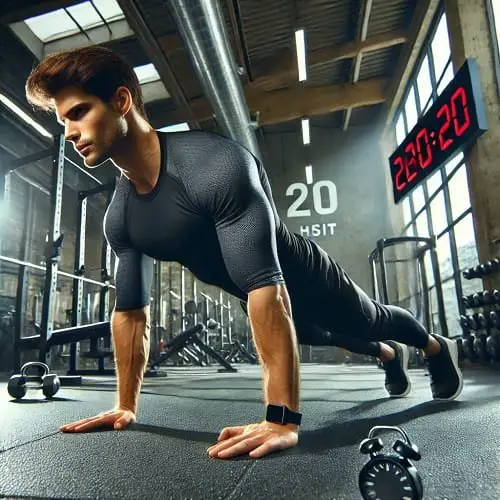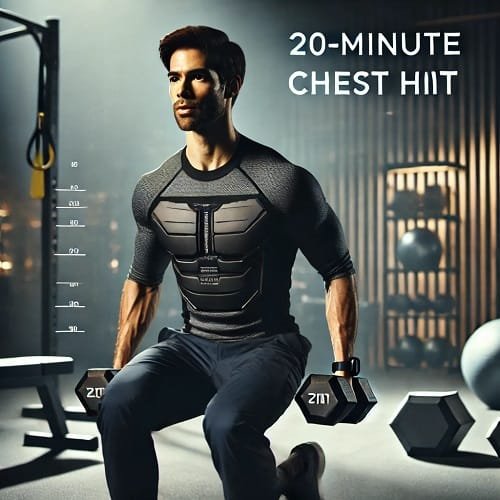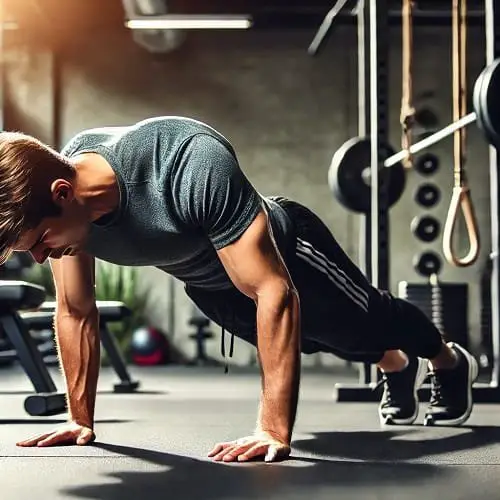1. Introduction
When it comes to fitness, time is often of the essence. We all want quick, effective workouts that deliver results without consuming hours in the gym. That’s where Chest HIIT Workout comes in. High-Intensity Interval Training (HIIT) has become one of the most popular methods for improving overall fitness, and when tailored to target specific areas like your chest, it can produce incredible results in a short amount of time.
HIIT for chest is a powerful combination of strength training and cardio. It focuses on pushing your body to its limits through short bursts of intense exercise followed by brief recovery periods. This method isn’t just about building muscle—it also aids in fat loss, enhancing your endurance, and improving overall cardiovascular health. The beauty of a Cardio workout for chest like this is that it targets both the heart and muscle groups simultaneously, providing a full-body workout in every session.
If you’re looking to build muscle, increase chest strength, and burn fat, then a 20-minute Chest HIIT Workout might be exactly what you need. The intensity of HIIT workouts accelerates your metabolism, ensuring that even after your workout ends, your body continues to burn calories. What’s even better? You can complete this highly effective routine in under half an hour, making it perfect for people with busy schedules. So whether you’re at home, the gym, or outdoors, this quick yet powerful routine is an excellent way to enhance your fitness goals and sculpt a stronger chest in no time.
Table of Contents
2. What is Chest HIIT and How Does It Work?

A Chest HIIT Workout is a unique and efficient training method that combines the power of HIIT exercises for chest with full-body fat-burning movements. HIIT, or High-Intensity Interval Training, is a training style that alternates between short bursts of intense effort and brief periods of rest. This training technique can be applied to various muscle groups, but when focused on the chest, it delivers a highly effective fat-burning chest workout that not only targets your chest muscles but also improves cardiovascular endurance.
What makes a Chest HIIT Workout so powerful is its ability to engage both muscle definition and calorie-burning simultaneously. During each session, you perform high-intensity workout intervals that keep your heart rate elevated, ensuring that your body burns fat at an accelerated rate. This results in improved overall fitness, while specifically sculpting the chest muscles. By using compound movements that target multiple muscle groups, you maximize your workout results in a shorter period of time compared to traditional, isolated strength training exercises.
But how exactly does this combination of strength and cardio work for muscle growth and fat loss? The science behind it is simple but effective. HIIT exercises for chest force your muscles to adapt to the intense, repetitive movements, leading to faster muscle recovery and growth. As you push your body through each interval, you stimulate muscle fibers, particularly those in the chest, which leads to greater muscle definition. Meanwhile, the elevated heart rate from the cardio aspect of the workout helps you burn fat, making it a highly efficient way to shape your chest while trimming overall body fat.
Moreover, Chest HIIT Workouts are not just about building muscle. They are designed to boost metabolism, keeping you in a state of fat burning even after the workout is complete. This afterburn effect, scientifically known as excess post-exercise oxygen consumption (EPOC), ensures that your body continues to burn calories and improve muscle tone long after the last set is finished.
3. Benefits of a 20-Minute Chest HIIT Workout

A Chest HIIT Workout may only take 20 minutes, but its benefits are immense and long-lasting. The efficiency of this workout format is a major draw for fitness enthusiasts. In just 20 minutes, you can experience maximum calorie burn, muscle growth, and improved endurance—all within a compact and highly effective session.
One of the key advantages of a 20-minute Chest HIIT Workout is its time efficiency. In a busy world, it’s easy to make excuses for skipping workouts. However, the short duration of a quick fat loss workout ensures that you can easily fit it into your day, no matter how tight your schedule may be. This makes it an ideal option for those looking to increase endurance and build muscle without dedicating hours at the gym.
Through consistent, high-intensity sessions, you can achieve lasting improvements in strength building workout and chest toning. The combination of intense intervals targets both the chest and the core, ensuring that your muscles continue to grow while simultaneously burning fat. Over time, these repeated sessions lead to more defined, sculpted muscles. The beauty of Cardio and strength training in one session is that you don’t just burn calories during the workout—you also build a strong foundation of strength that improves over time.
Additionally, high-intensity training is a proven way to burn fat. Since your body is working at maximum capacity during each interval, the calories continue to burn even after the session ends, thanks to the afterburn effect (EPOC). This means you’re actively reducing overall body fat while building a strong chest.
Finally, incorporating Chest HIIT Workouts into your routine will have a significant impact on your cardiovascular health. As your heart rate increases during each interval, your endurance and heart health improve, contributing to a more balanced and healthier body overall.
4. How to Perform a Chest HIIT Workout

Performing a Chest HIIT Workout is simple and can be tailored to different fitness levels, from beginners to advanced athletes. The beauty of this workout lies in its ability to combine strength-building chest movements with cardio intervals, all while targeting your chest and upper body. Here’s a step-by-step guide to get the most out of your workout.
Step 1: Warm-Up
Before jumping into the high-intensity intervals, it’s important to warm up your body with some light cardio and dynamic stretches. Spend about 5 minutes doing arm circles, shoulder rolls, and light jogging or jumping jacks to increase your heart rate and prepare your muscles for the upcoming Chest-focused HIIT.
Step 2: Perform the Chest HIIT Exercises
Here are some excellent exercises to include in your Chest HIIT Workout. For each exercise, aim for 40 seconds of intense work followed by 20 seconds of rest. Repeat each round for 3 sets before moving on to the next exercise.
- Push-Ups
- Form: Get into a high plank, placing your hands a bit wider than shoulder width. Lower your chest to the floor, then push back up to the starting position.
- Modifications: For HIIT for beginners, perform the push-ups on your knees, or incline them on a bench to reduce the intensity. For advanced users, try clap push-ups or one-arm push-ups.
- Chest Press (Dumbbells or Bodyweight)
- Form: Lie on your back, holding dumbbells with both hands at chest level. Push the dumbbells up until your arms are completely extended.. If you don’t have dumbbells, try performing a bodyweight chest press by doing incline push-ups or push-ups with your hands elevated on a sturdy surface.
- Modifications: For beginners, use lighter weights or focus on slow, controlled bodyweight push-ups.
- Burpees
- Form: Stand with your feet shoulder-width apart. Squat down, place your hands on the floor, jump your feet back into a plank, perform a push-up, jump your feet back in, and explode upward into a jump.
- Modifications: If you’re a beginner, skip the push-up and jump, focusing on stepping back instead of jumping.
- Mountain Climbers
- Form: In a high plank position, alternate bringing your knees towards your chest at a rapid pace, almost as if running in place.
- Modifications: For beginners, slow down the movement, and focus on form rather than speed.
Step 3: Cool Down
Finish your Chest HIIT Workout with a 5-minute cool-down that includes stretching and deep breathing exercises. Focus on stretching the chest, shoulders, and triceps to avoid stiffness and improve flexibility.
Step 4: Scale for Fitness Levels
- HIIT for Beginners: Start with 20 seconds of work and 40 seconds of rest, focusing on form before intensity. Gradually increase the work time as you build strength.
- Advanced Users: Increase the intensity by adding weights, performing exercises faster, or incorporating more complex movements like plyometric push-ups or explosive chest presses.
Tip for Injury Prevention
If you have existing injuries or mobility issues, consider modifying exercises. For example, avoid burpees if you’re dealing with joint pain and opt for chest presses or push-ups at an incline instead.
ALSO READ
Top 7 Front Shoulder Workouts to Build Strength and Muscle
Ultimate Wrestling Workouts to Build Strength and Power
Neck Harness Workout for Explosive Strength Gains
Ultimate Body Recomposition Workout Plan for Fast Results
5. Sample 20-Minute Chest HIIT Routine

If you’re looking for a quick chest workout that is both effective and time-efficient, this 20-minute Chest HIIT Workout is exactly what you need. It combines effective HIIT moves to target your chest, while also incorporating fat-burning routines to boost your metabolism and overall fitness. Whether you’re using bodyweight exercises or incorporating dumbbells for added resistance, this routine will help you build strength and endurance in just 20 minutes.
Here’s a practical Chest HIIT Workout routine designed for all fitness levels. Work for 40 seconds on each exercise, then take a 20-second break. Complete 3 rounds of the entire circuit, resting for 1 minute between rounds.
I. Push-Ups (Bodyweight)
- Form: Get into a high plank position, maintaining a straight body and tight core. Drop your chest to the ground, then push yourself back up.
- Sets: 3
- Rounds: 3
- Rest: 20 seconds after each round
- Tip: Keep your elbows at a 45-degree angle from your body and avoid letting your hips sag.
II. Explosive Push-Ups
- Form: Begin in a push-up position. As you push up, do so with enough force to lift your hands off the ground. You can even clap your hands if you’re comfortable.
- Sets: 3
- Rounds: 3
- Rest: 20 seconds after each round
- Tip: Focus on explosiveness while maintaining proper form. If you’re a beginner, opt for regular push-ups or knee push-ups instead.
III. Chest Press with Dumbbells
- Form: Lie on your back, holding a dumbbell in each hand at chest level. Raise the weights until your arms are fully straightened. Lower back down with control.
- Sets: 3
- Rounds: 3
- Rest: 20 seconds after each round
- Tip: Make sure to keep your elbows at a slight angle—don’t lock them out to avoid injury.
IV. Mountain Climbers (Bodyweight)
- Form: Start in a plank position. Rapidly alternate bringing your knees toward your chest as if you’re running in place.
- Sets: 3
- Rounds: 3
- Rest: 20 seconds after each round
- Tip: Keep your body in a straight line and avoid letting your hips rise.
V. Chest Flys with Resistance Bands
- Form: Stand tall with a resistance band in both hands. Stretch the band across your chest and slowly return to the starting position.
- Sets: 3
- Rounds: 3
- Rest: 20 seconds after each round
- Tip: Keep tension on the band throughout the movement for maximum activation.
VI. Burpees (Bodyweight)
- Form: Start standing, squat down, place your hands on the floor, jump back into a plank, do a push-up, jump your feet back in, and leap into the air.
- Sets: 3
- Rounds: 3
- Rest: 20 seconds after each round
- Tip: Keep your core tight and avoid letting your back arch during the push-up phase.
VII. Plank to Push-Up
- Form: Start in a forearm plank position. Push up into a high plank, one arm at a time, then return to the forearm plank.
- Sets: 3
- Rounds: 3
- Rest: 20 seconds after each round
- Tip: Engage your core to keep your body stable. Focus on controlled movements.
Cool Down (5 Minutes)
After completing the Chest HIIT Workout, spend 5 minutes cooling down with static stretches. Focus on stretching your chest, shoulders, and arms to improve flexibility and reduce muscle tightness.
This Bodyweight HIIT workout is not only great for beginners but also scalable for more advanced fitness levels. You can modify the intensity by increasing work time, adding more rounds, or incorporating heavier weights for resistance. Whether you’re focusing on chest exercises for strength or looking to boost your overall fitness, this routine will help you achieve your goals in just 20 minutes.
6. Tips for Maximizing Results from Your Chest HIIT Workout

To truly see chest muscle growth and improve your strength and endurance, it’s essential to push the intensity of your Chest HIIT Workout. Here are a few tips to maximize your results:
- Increase HIIT Intensity: As you get stronger, gradually increase the intensity of your Chest HIIT Workout. You can do this by increasing the number of rounds, reducing rest time between sets, or adding resistance with dumbbells or resistance bands. Higher intensity will stimulate more muscle fibers, leading to faster gains.
- Progressive Overload: To avoid hitting a plateau, progressively overload your muscles. This means increasing the weight or resistance, performing more reps, or intensifying the workout every few weeks. This strategy helps continuously challenge your body and stimulate chest muscle growth.
- Consistency is Key: Perform your Chest HIIT Workout regularly (at least 3-4 times a week) for consistent improvements. Consistency will not only help in building strength and muscle, but also improve your cardiovascular fitness over time.
- Optimal Rest and Recovery: Don’t underestimate the importance of rest. Adequate recovery, including taking rest days, will allow your muscles to repair and grow stronger.
- Nutrition Support: Fuel your body with the right nutrition. Make sure to consume enough protein to support muscle repair and growth, along with a balanced diet to fuel your high-intensity workouts.
By following these tips, you can take your HIIT intensity to the next level, ensuring that each workout helps you achieve better performance and faster results.
7. Common Mistakes to Avoid During a Chest HIIT Workout

When performing a Chest HIIT Workout, many people make common workout mistakes that can hinder progress or even lead to injury. By being mindful of these issues and correcting them, you can ensure that your workout is both safe and effective. Here are some common mistakes to avoid:
- Poor Form During Chest Exercises: One of the most frequent HIIT form issues is improper technique, especially during push-ups, chest presses, and other chest exercises. Whether it’s flaring your elbows too wide or not engaging your core properly, bad form can reduce the effectiveness of the workout and increase the risk of injury. Always focus on keeping your body aligned, shoulders away from your ears, and elbows in the right position to maximize the benefits.
- Rushing Through Exercises: It’s tempting to rush through Chest HIIT Workouts in an effort to finish quickly, but doing so sacrifices quality. Speeding through movements reduces the time under tension for your muscles, which is essential for muscle growth and endurance. Take your time with each exercise, focusing on controlled, precise movements rather than speed.
- Skipping the Warm-Up: Not warming up before your Chest HIIT Workout can lead to muscle strains and other injuries. A proper warm-up helps prepare your muscles for the intense exercises ahead and gets your blood flowing. Always dedicate at least 5–10 minutes to dynamic stretching and light cardio before starting.
- Inadequate Rest or Recovery: Failing to allow proper rest or recovery between sets or sessions can hinder muscle growth and leave you fatigued. Ensure that you’re taking sufficient rest periods (typically 20 seconds between sets) and giving your muscles time to recover.
By focusing on correct form for chest exercises, avoiding rushed movements, and taking time to warm up and rest properly, you can prevent injury during HIIT and achieve the maximum benefits from your workout.
8. How Often Should You Do a Chest HIIT Workout?

When planning your Chest HIIT Workout routine, workout frequency is a crucial factor in maximizing results. For most individuals, performing a Chest HIIT Workout 2-3 times a week is ideal. This allows enough time to push your chest muscles to their limits while also providing adequate rest for recovery and growth. Overdoing it can lead to burnout or injury, so it’s important to strike the right balance.
The key to muscle growth is ensuring you give your body time to recover. Optimal recovery involves taking rest days between high-intensity workouts, allowing your chest muscles to repair and rebuild stronger. When planning your chest workout schedule, incorporate rest days or lighter workouts (such as lower-intensity cardio or stretching) between your HIIT sessions.
For a balanced approach, consider combining your Chest HIIT Workout with other training sessions, like leg day or full-body HIIT routines. This combination ensures you’re targeting multiple muscle groups and avoiding overtraining any single area, promoting overall strength and preventing imbalances.
By following a well-structured schedule with sufficient rest and recovery, you’ll optimize both muscle growth and overall fitness.
9. Frequently Asked Questions (FAQs)
1. How can I see results in just 20 minutes with a Chest HIIT Workout?
A Chest HIIT Workout is designed to be high-intensity and time-efficient. In just 20 minutes, the combination of short bursts of intense effort and minimal rest can significantly elevate your metabolism and burn fat. By targeting your chest with compound exercises, you’ll also engage multiple muscle groups, leading to faster muscle activation and growth. Consistent training will help you see fast results.
2. Can beginners try a Chest HIIT Workout?
Absolutely! A Chest HIIT Workout can be adapted for beginners by starting with simpler exercises and adjusting the intensity. Beginners should focus on learning proper form and progressively increasing the intensity over time. If you’re just starting out, consider working with bodyweight exercises like push-ups before adding weights or more complex movements.
3. Is it better than traditional weight lifting?
While both HIIT for muscle growth and traditional weight lifting have their benefits, Chest HIIT Workouts offer a unique advantage in terms of time efficiency and fat loss. Weight lifting focuses on muscle building through slower, controlled movements, while HIIT combines cardio and strength to improve both endurance and muscle tone simultaneously.
4. How does HIIT help with fat loss?
HIIT helps with fat loss by increasing your heart rate and metabolism, leading to calorie burn during and after the workout. The fat-burning chest workout nature of HIIT keeps your body in a heightened metabolic state, promoting continued fat loss even after the workout is complete.
10. Conclusion
Incorporating a 20-minute Chest HIIT Workout into your fitness routine offers numerous benefits. It helps build a stronger chest, enhances muscle tone, and supports fat loss. By combining high-intensity intervals with chest-focused exercises, this workout allows for fast results in a short time frame. So, why wait? Start your effective HIIT workout today and watch your chest sculpt into the shape you’ve always wanted. Keep challenging yourself, and don’t forget to track your progress!






